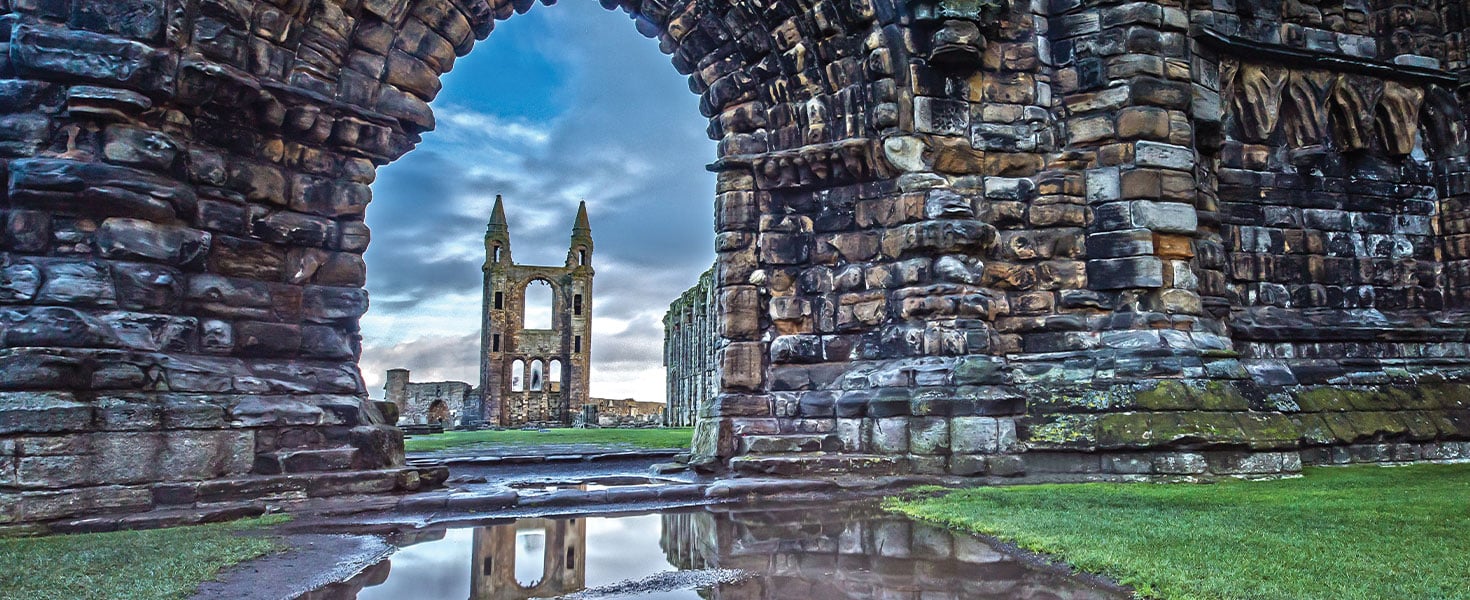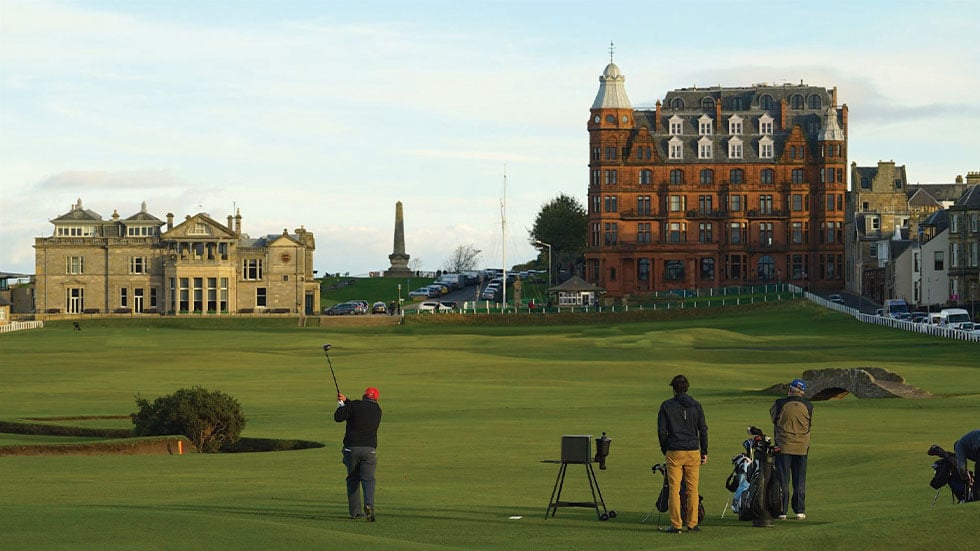Discovering the Soul of St. Andrews, Scotland
From ancient ruins to a bustling university, St. Andrews offers so much more than great golf

On an easy train ride from Edinburgh north along the North Sea coast, I look out on a landscape dotted with stone spires and winding footpaths on one side and the wide sea on the other. I’m passing through the verdant landscape of County Fife (where the series Outlander was filmed) to a destination of stony beauty: St. Andrews, famously the birthplace of golf and home of the Royal and Ancient Golf Club.

Golfers approach the last hole on the Old Course; Photo courtesy of EatWalk Tours
The undulating fairways are among my first glimpses of St. Andrews as I journey by bus from the rural train station to town. The greens of the 1754 Old Course are pocked by dunes and thorny gorse shrubs.
But the town offers much more than golf. Dating back to an 8th-century monastery that reportedly held the relics of Saint Andrew, an apostle of Jesus, this ancient town combines northern hardiness with the independent thinking of the United Kingdom’s third-oldest university, named for the town. People here have been challenging conventional thought since before the Reformation.
As a place of deep-rooted traditions and new ideas, the town has long held a grip on the northern kingdom’s imagination. Saint Andrew became the patron saint of Scotland, and his flag—a blue cross on a white background—became its emblem. The town’s cathedral was the country’s largest church when it was finished in 1318.

Ruins of the medieval cathedral in St. Andrews, Scotland; Photo by susanne2688/stock.adobe.com
AN ANCIENT QUAD
That history first drew me as a college student four decades ago. On my recent return trip, I wondered if that rugged charm would have burned off like sea mist. I worried that I would find a place homogenized by global brands.
As I strolled through town to get my bearings, new things stood out: the Starbuck’s mermaid and international retail chain H&M among them. While those could be expected, I found that the soul of the place remains the same: The town is still a walkable batch of cobbled lanes that fan westward from the ruins of the medieval cathedral, its two spires flanking an arch of sky. The stone structure has been slowly decaying ever since the day in 1559 when a mob, stirred by fiery Protestant reformer John Knox, ransacked it.
The town has quieted down since the time of Knox, though some special university days like Raisin Sunday bring out students in boisterous throngs. For generations, this fall rite has cemented ties between first-year students and their wiser upperclass “parents.” On Raisin Sunday, dutiful first-years bring gifts to their academic mothers, and the parents repay that with a pub crawl through town. Too early the next morning, the ritual concludes with Raisin Monday, where the first-years, decked in ridiculous costumes, flock to the Quad. An insane Monty Python-esque scene ensues with flour and suds flying (after all, John Cleese once served as the university’s Rector, an honorary position elected by the students every three years).

The Quad at St. Andrews; Photo by David Taylor
Since my own Raisin Monday, the campus stones have sprouted new landmarks to local history. One stands just off the Quad on the seaside lane of The Scores, with its breathtaking terrace view. It opened as the Museum of the University of St. Andrews in 2008, with internationally famous crime novelist Ian Rankin, a Fife-born honorary graduate, on hand. Having penned a novel about a museum robbery, Rankin got to “meet” body snatchers in the collection, represented by their death masks. Very St. Andrews.
Renovated in 2021, the building has reemerged as the Wardlaw Museum, with the original mosaic floor and display cases moved from the university’s natural history museum of a century ago. A changing program of exhibitions reflects the university’s research and impact on the town and the world, according to Matt Sheard, head of experience and engagement. An evocative photography exhibit, “Return to Mingulay,” on view until January 7, 2024, explores a Scottish wilderness left virtually untouched by humans for a century.
Photography actually has deep roots in St. Andrews, which has been a world center of the art ever since Thomas Rodger turned his lens on the town and its people in the 1800s. Downtown, the photographer’s restored home commemorates his legacy. A plaque in front notes, “His pictorial record of the town, its people, the fisher folk and eminent visitors, brought him great fame.”

The castle ruins provide a vista for the changing skies over the North Sea; Photo by JulietPhotography/stock.adobe.com
OUT AND ABOUT
I continue my walk to the town’s 15th-century stone castle and its tunnels, added in the next century. From there, I take a once-familiar path to the harbor, where working fishing boats testify to life on the sea. On Sunday mornings, just as they did in my years there, the university’s young minds file out to the stone pier in a blood-red-robed line, an age-old practice. During their walk, tradition dictates, the students hurl curses southward at a long-dead English King, Edward I, aka “Longshanks,” Scotland’s nemesis for centuries (until the two kingdoms united their thrones in 1707).
All around town, I find a newer version of the blend of Scottish charm and international flavor that I remember. I have a long-held memory of careening around the floor in a Scottish folk dance (ceilidh) and hearing bagpipes echo off storefronts on North Street—and then catching a new play. This time, I see notices of a fresh production of Little Women and a play about climate change at the Byre Theatre. The weathered stone and winding streets make for an easy wander. I pause in East Neuk Books and feel the intensity of young minds at work.
By now feeling peckish, I consider my options. Near the cathedral, Cromar’s is an excellent stop for fish-and-chips doused with a generous spray of vinegar. I savor the meal at an outdoor table facing Market Street.

St. Andrews; Photo by Daniel Zimmermann/stock.adobe.com
HILLS TO ROAM
After sating my hunger and eager for a longer stroll, I take to the footpaths that lace the gentle hills surrounding the town and unfurl beside the cliffs overlooking the sea toward nearby hamlets. Thanks to Scotland’s 2003 “Right to Roam” act, which formalized the public’s recreational freedom to follow byways along private land, my exploration of the countryside brings a series of inviting turnstiles and fields.
The day before, in the lowlands, I had lazed along worn paths, not sure where they were leading me, with the assurance that I wouldn’t be shouted down for trespassing (as long as I kept moving). Even when I couldn’t see where a path led, I would walk to the edge of a field to find it turning and then learn my new direction only a few feet away.
As the sky darkens, I head back from the hills into downtown St. Andrews, where the sun drops into fields and late shadows stretch over the water. It’s time to settle in for the evening, in a place that sounds with footsteps on local stones and the breeze from a larger world.
